| Gourd #8 By René White Feather A Native American Handicraft of Northern Virginia This unusual gourd is most beautiful in its nature and unadulterated state. When I first saw it, I could hear music with my eyes. What a joy to enhance it with broken green shards, iridescent hummingbird feathers and imitation sinew strings. Sinew is tough fibrous tissue that unites a muscle to bone. It is basically a tendon or ligament. Your Achilles tendon is sinew. Native Americans use sinew and feathers from four legged and winged animals and birds, as cords & bows, stringing beads, tying garments, and enhancing cultural crafts. While all sinew is a durable fiber, this instrument lacks stringing function. Honestly, I lacked the technical ability to tighten the strings using turning pins. This is my first gourd that wanted to be a musical instrument. It is primitive, one-of-a-kind, and I have much to learn. This is my eighth gourd in a series I would like to enhance. The first mark made on this gourd is at the base of the neck or column. Using my first burning tool, gifted to me by my oldest sister Bea, I spent countless hours burning this piece. It is not the hours I count, but the memories. Perhaps it is memories of family and home that led to this design. Or perhaps it is because my sister is a retired school teacher who cannot stop influencing. The basic design began as pine-tree bark. I grew up in the pines. All my people are surrounded by the pines and our Lumber River. In the 60’s and 70’s I grew up listening to one of our significant tribal musicians, Willie Lowery (1944-2012), who wrote a Lumbee arrangement of the famous Appalachian tune, “In the Pines.” His rendition of this song would become a kind of anthem for my people and me. Willie also wrote a song for us young children called, “Proud to be a Lumbee.” For the first time, our generation of children sang, “I can be anything I want to be… I am proud to be a Lumbee Indian.” Exhibitions. This piece is on exhibit at the Burwell-Morgan Mill in the quaint village of Millwood, Virginia. The show runs from April 26 - May 11, 2014. | They say I was the first female commissioned in the military from our tribal university. Many years later, and now a grandmother, now I can finally say I am an artist. Many people pass through our lives and influence us. Our designs. Our path. At the top of the neck, two lone feathers mark the transition to the solid pine-tree green which slowly blends to chartreuse. Chartreuse is one of those unexpected and underappreciated colors – like many people. As I held the instrument against me, I imagined what the person owning it would see. It was then that I imagined feathers flowing around the base. As the base of feathers began to take shape, the bark transformed into a combination of pine-tree bark and feathers. The whole design was not imaged from the beginning. None of my work is. Life if like that. We cannot plan it all out. We just have to go with the flow. Sometimes life hands us chartreuse, and you go with it. My friend Alan Stanz, who plays the Native American flute wonderfully told me, “Playing an instrument is finding your soul.” If this instrument could play for you, what sound would it make? Rock? Blues? Hip hop? Classical? Gospel? Grocery store music? Reggae? Tribal? Only the owner knows. Music for this piece is left to the eyes of the beholder. Thank you for appreciating it, not just its enhancements, but its nature beauty and what it creates in you and others. Medium & Materials. Naturally dried Virginia gourd, burned, slightly carved then enhanced using water-based pine-tree green & chartreuse ink, heat set and sprayed using gallery conservation varnish, and accented with green stones, bamboo, sinew, and iridescent hummingbird feathers. |
|
0 Comments
Your comment will be posted after it is approved.
Leave a Reply. |
Rene' Locklear WhiteOutdoor Classroom for Categories
All
|


 RSS Feed
RSS Feed